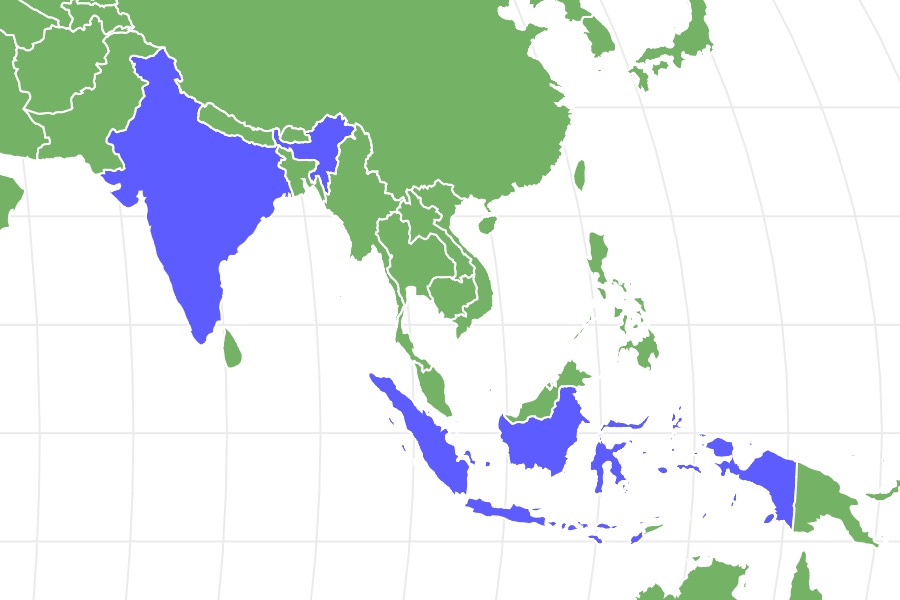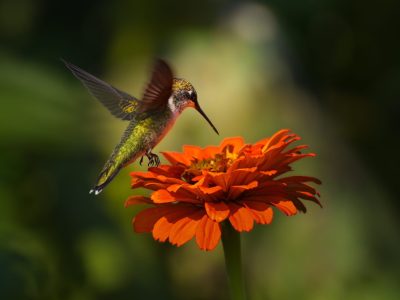Flying Snake
Chrysopelea ornata
Flying snakes are the only gliding limbless vertebrates or animals with a backbone!
Advertisement
Flying Snake Scientific Classification
- Kingdom
- Animalia
- Phylum
- Chordata
- Class
- Reptilia
- Order
- Squamata
- Family
- Colubridae
- Genus
- Chrysopelea
- Scientific Name
- Chrysopelea ornata
Read our Complete Guide to Classification of Animals.
Flying Snake Conservation Status
Flying Snake Facts
- Prey
- Rodents, bats, birds and their eggs, frogs, smaller snakes, and lizards
- Name Of Young
- Hatchlings, snakelets
- Fun Fact
- Flying snakes are the only gliding limbless vertebrates or animals with a backbone!
- Habitat
- Forests and jungles of southeast Asia, India, Sri Lanka, and China
- Diet for this Fish
- Omnivore
- Number Of Species
- 5
View all of the Flying Snake images!
Flying snakes don’t really fly — they glide!
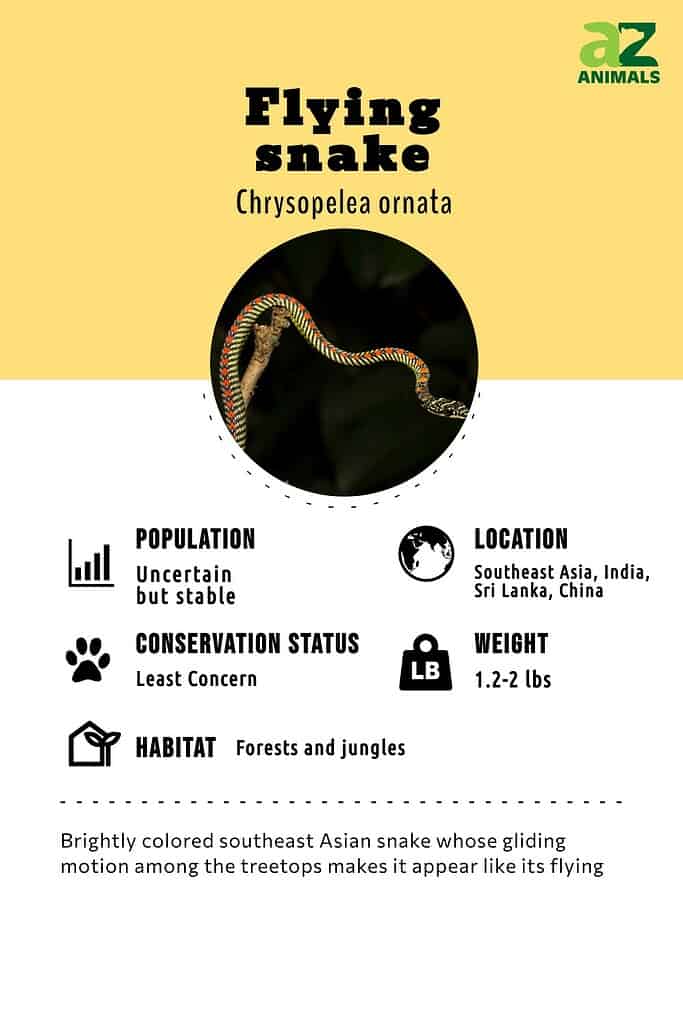
Though they don’t fly like birds or bats, the very sight of these brightly colored southeast Asian snakes “swimming” through the air between trees is awesome. Scientists are studying flying snakes and figuring out just how flying snakes “fly,” but for the snake, it’s just another life skill. Gliding saves time and energy when it’s time to hunt for prey and avoid being hunted.
Four Amazing Facts About Flying Snakes
- The beautiful paradise tree snake is the most skilled glider of all the flying snakes.
- Flying snakes are the best gliders of all gliding animals, as they don’t have to bother with drag-producing limbs. Indeed, they’re the only gliding limbless vertebrates or animals with a backbone.
- These snakes can glide at speeds up to 25 miles per hour and as far as 78 to 300 feet at a time.
- Smaller snakes are better at gliding than larger ones.
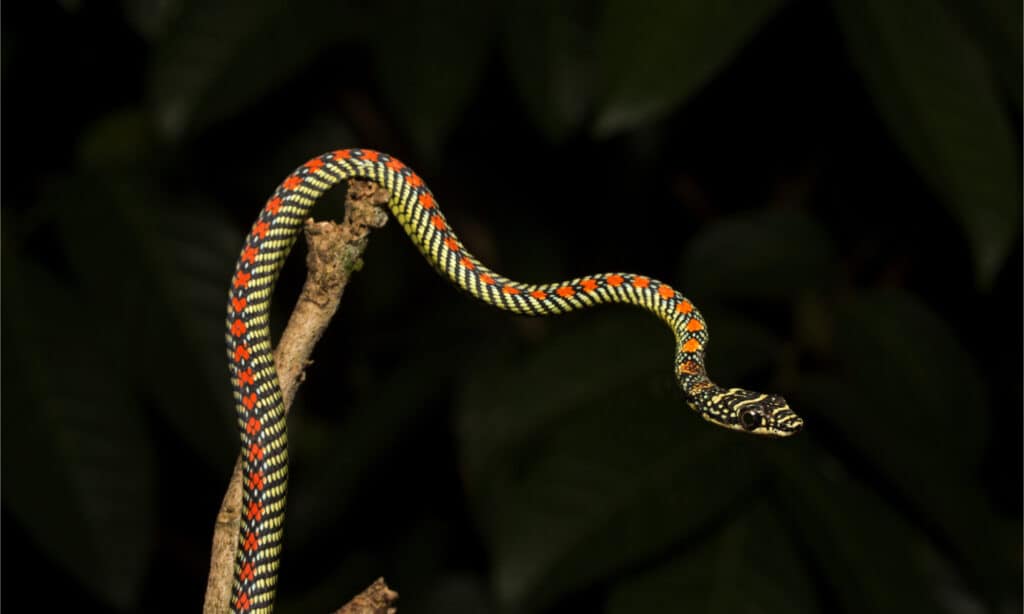
Paradise tree snakes are thought of as the best gliders out of the five flying snake species.
©Vince Adam/Shutterstock.com
Scientific Name
The flying snake’s scientific name is Chrysopelea ornata. The genus they belong to is Chrysopelea. Interestingly, scientists don’t know where the genus name comes from, though “chryso” seems to be taken from the Greek word chrysos which means “golden.”
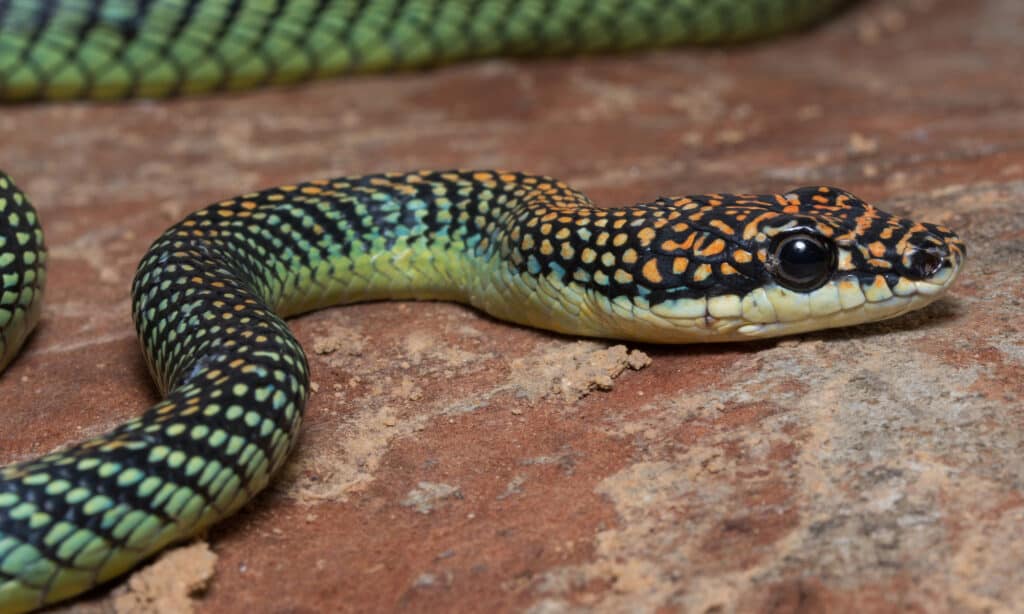
Flying snakes belong to the
Chrysopelea
genus.
©Nenad Preradovic/Shutterstock.com
Evolution and History
While flying snakes, also known as gliding snakes, were recognized in the 1890s, scientists have been studying their unique abilities only over the past 20 years and as a result, there is limited information available on the species, including how they evolved and their history.
Flying snakes belong to the family Colubridae, which is the largest snake family with 249 genera. The earliest species of colubrids date to the Oligocene Epoch and they are present on every continent except Antarctica.
In a summary of the known information about gliding flight in snakes in the journal “Integrative and Comparative Biology,” John J. Socha theorizes that flying snakes may have first moved through the air to cross gaps in the canopies of their forest and jungle habitats or to escape predators, a behavior that evolved into gliding. It’s been found that the flying snake rotates its ribs to flatten its whole body while in the air, which is similar to how a cobra forms a hood and how snakes such as the death adder, red-tailed pipe snake, and Australian red-bellied black snake behave. However, because the flying snake is the only one to move from one place to another while flattened, it seems that this species’ evolution involved different and special musculoskeletal adaptations to enable it to glide.
More studies are needed, including ones that track flying snakes’ movements in the wild, to be able to gain more information about these snakes and their abilities and behavior.
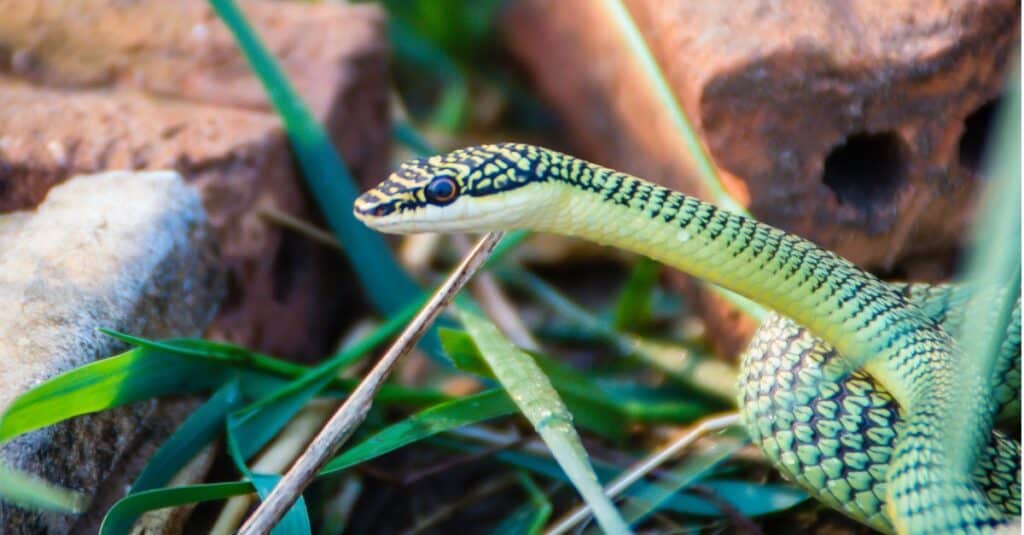
There is limited data about the flying snake species in the wild.
©iStock.com/Kwhisky
5 Species of Flying Snakes
There are five species of flying snakes:
- Golden tree snake (Chrysopelea ornata), also known as the ornate flying snake and golden flying snake
- Paradise tree snake (Chrysopelea paradisi), also known as the paradise gliding snake and garden flying snake
- Banded flying tree snake (Chrysopelea pelias), also known as the twin-barred tree snake
- Moluccan flying snake (Chrysopelea rhodopleuron)
- Sri Lankan flying snake (Chrysopelea taprobanica), also known as the Indian flying snake.
The golden tree snake has three subspecies. They are:
- Chrysopelea ornata ornata
- Chrysopelea ornata ornatissima
- Chrysopelea ornata sinhaleya.
The paradise tree snake also has three subspecies. They are:
- Chrysopelea paradisi paradisi
- Chrysopelea paradisi celebensis
- Chrysopelea paradisi variabilis.
The Moluccan flying snake has two subspecies. They are:
- Chrysopelea rhodopleuron rhodopleuron
- Chrysopelea rhodopleuron viridis.
Unlike a lot of reptiles and other animals that belong to the same genus, these snakes can often be told apart according to their habitat and species. The golden tree snake is the largest of the snakes. It can grow up to four feet long, and its size keeps it from gliding as gracefully as the other members of Chrysopelea. Despite its name, it can be mostly green, yellow, or red with different color markings.
The paradise tree snake can be three feet long and is sometimes kept as a pet. Its body has a black background with a pattern of beautiful green bands marked with orange, red, or yellow. The paradise flying snake is one of the most agile of the species.
The banded flying snake grows to only two feet. Its body has a black or dark gray ground that is embellished with slender yellow, red, and black bands. It is quite rare, and despite its small size, it’s not as good a glider as the paradise tree snake.
The Moluccan flying snake comes in shades of green with dark bands and, sometimes, orange or red spots between them.
Present in dry lowland areas of India and Sri Lanka, the Sri Lankan flying snake is medium-sized and covered in in dark bands and green to yellow scales. It can also appear with orange or red spots and reach up to 35 inches long.
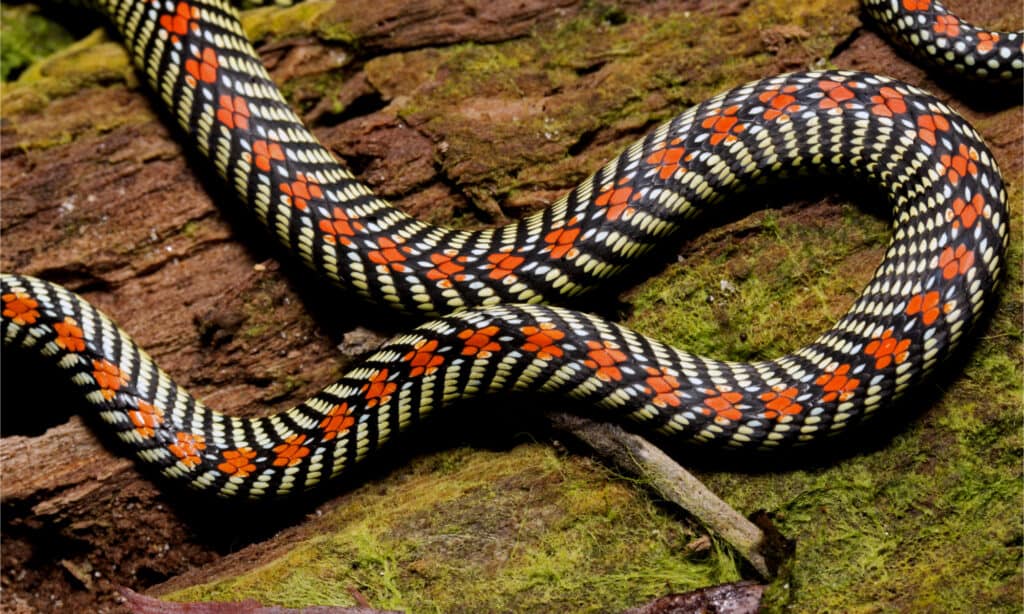
Paradise flying snakes have beautiful diamond-shaped markings.
©Vince Adam/Shutterstock.com
Appearance and Behavior
Generally, these snakes are slender with beautiful colors and patterns on their sides and tops and yellow scales on their bellies. They are not large and rarely grow longer than 4 feet, and they weigh from 1.2 to 2 pounds. Their snout is pointed and flat, and their eyes are large and dark. Of course, the one thing that identifies them right away is that they glide from place to place. If you see a snake undulating through the air as if it’s swimming in the water, that is a flying snake.
Biologists believe that these snakes glide from tree to tree to find food and to escape danger, which often comes in the form of a bird of prey. The snake climbs to the very end of a tree limb, picks out a place to land, twists its body into a J shape then simply flings itself off the branch toward the target. While in flight, it flattens out its ribs and makes itself twice as wide as it usually is, turning its body into something of a frisbee.

A flying snake’s snout is pointed and flat, and its eyes are big and dark.
©reptiles4all/Shutterstock.com
How Dangerous Are Flying Snakes?
The venom of these snakes is not life-threatening to humans and is used to subdue their prey. Their venom is delivered from the fangs at the back of their mouth, which makes it hard for them to envenomate a human. However, a bite from one of these snakes still shouldn’t be taken lightly, for it can cause pain and swelling. People are often treated with local painkillers and given a tetanus shot if they need one.

The flying snake’s venom is not life-threatening to people, but medical treatment should be sought.
©Kurit afshen/Shutterstock.com
Habitat
These snakes are found in the forests and jungles of southeast Asia, India, Sri Lanka, and China. They are considered arboreal snakes because they live in the trees and rarely come down to earth.
The golden tree snake lives in India, China, Thailand, and the Philippines, among other locations. The paradise tree snake’s habitats include the forests, coastal forests, and coconut palm trees of Thailand, Cambodia, Indonesia, India, Malaysia, the Philippines, Singapore, and Bangladesh. In addition to tree-dwelling, they also hide in holes or under logs. This species lives in areas where its most common prey, lizards and frogs, is present in abundance.
The Moluccan flying snake is largely found in Sulawesi and Ambon, Indonesia. The Sri Lankan flying snake is found, of course, in Sri Lanka, as well as in India, in old growth forest trees and national parks, where it frequently eats lizards and birds.
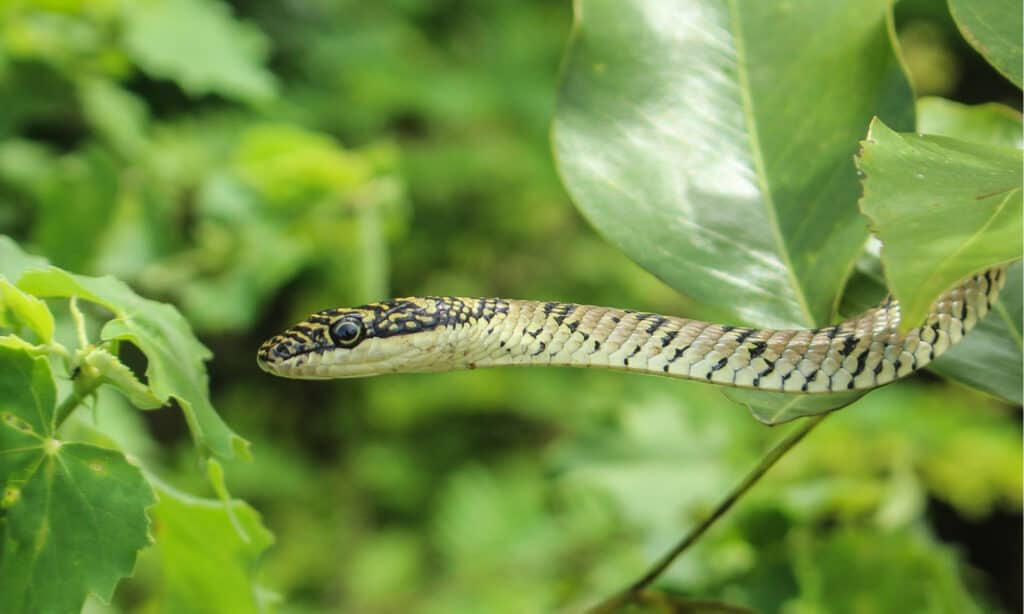
Flying snakes are classed as arboreal snakes because they live in the trees.
©Saranga Athukorala/Shutterstock.com
Diet
These snakes are diurnal which means they hunt during the day. Despite the fact that they’re not very large snakes, they take a variety of animals that may be much larger than the diameter of their head. These include rodents, bats, birds, and their eggs, frogs, smaller snakes, and lizards.
Flying snakes help humans by eating vermin such as mice and rats, and they regulate the populations of other animals such as birds, reptiles, and frogs.

The flying snake’s diet includes mice.
©jitkagold/Shutterstock.com
Predators and Threats
While some consider flying snakes as being without natural predators, it is likely that this species has them, supporting the theory that their gliding skills developed in part to help them evade predators. It’s possible that birds of prey and larger snake species could hunt, kill, and eat them in the same way they do to many snakes found in similar habitats.
Humans could also be a threat if they mistake the snake as being dangerous to people. In some areas where it’s found, it’s also considered a food source.

People mistake the flying snake for being a dangerous, deadly species.
©Vince Adam/Shutterstock.com
Reproduction and Lifespan
Not much is known about how flying snakes mate, but biologists do know that they lay about 6 to 12 eggs at a time in mid-spring. The gestation period is not known either but the baby snakes are brilliantly colored and are about 6 to 7.9 inches long when they hatch, usually in June. The lifespan of these snakes is about 10 years.
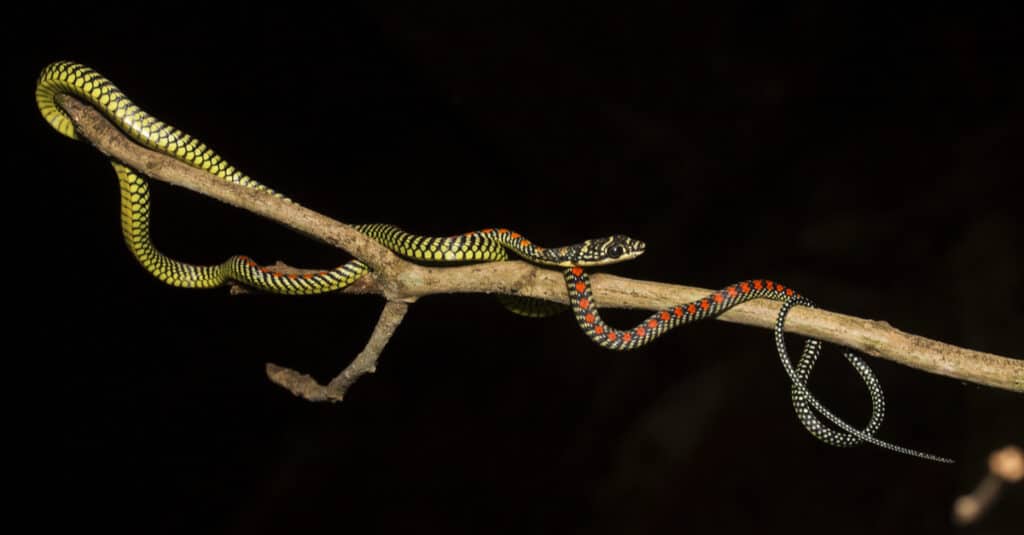
Flying snakes typically live for around 10 years.
©Vince Adam/Shutterstock.com
Population
The flying snake’s populations are mostly stable, and their conservation status is of least concern. The paradise tree snake was assessed for the ICUN Red List in 2011 and was classified as stable across several countries in Asia.
Flying snakes do not appear to have any issues when it comes to food sources as their habitats contain common and easily available prey. This snake is remain safe from being hunted by predators because it can avoid many of them by living in tree canopies and gliding to escape if threatened.
As flying snakes are not common in the pet trade, they are not currently at risk of being poached for sale. As long as their habitats stay somewhat protected, they are not in any danger of extinction.
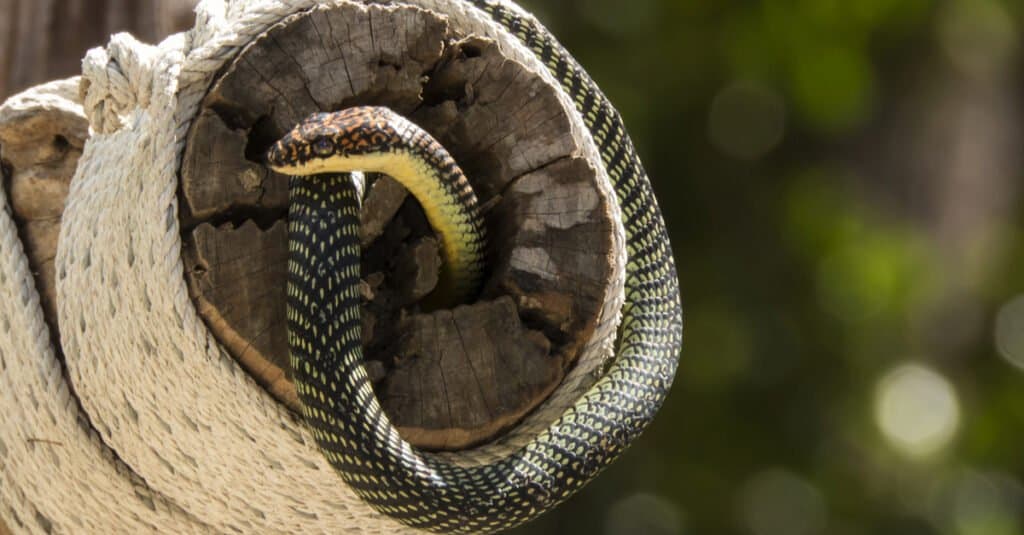
The flying snake’s conservation status is of least concern.
©PACO COMO/Shutterstock.com
Similar Animals
View all 91 animals that start with FFlying Snake FAQs (Frequently Asked Questions)
Are flying snakes venomous?
Flying snakes are mildly venomous. Their venom is life-threatening only to their prey. Yet they are seen constricting prey to death or even snapping their necks to kill them.
Their venom is not very harmful to humans.
How do flying snakes hunt?
Flying snakes hunt like most other snakes, using their Jacobson’s organ to identify the molecules laid down by potential prey. The one difference is they can glide from tree to tree in search of prey which other snakes cannot.
Are flying snakes aggressive?
Flying snakes don’t seem to be particularly aggressive, but they bite if they don’t like being handled.
Where do flying snakes live?
Flying snakes live in southeast Asia from India to Indonesia.
What is a flying snake?
A flying snake is a small, jewel-colored snake that can glide. It is the only limbless vertebrate that can do so.
Can a flying snake bite you?
A flying snake can bite if it is annoyed, but the wound is not dangerously venomous.
Do flying snakes really exist?
Yes, they do! Except they don’t actually fly but glide instead.
How do flying snakes fly?
Flying snakes “fly,” by flattening out their ribs and undulating and twisting their bodies through the air. They use their tail, which is long for a snake, as a sort of rudder.
How far can a flying snake fly?
The snake can fly as far as 300 feet away, though they have more control if they glide through an area that’s about 78 feet long.
Where do flying snakes live?
Flying snakes live in the mid-stories of jungles, forests, and woods of southeast Asia from India to Indonesia.
What is the largest species of flying snake?
The largest flying snake species is the golden tree snake (also known as the ornate flying snake). It measures up to 4 feet in length. The smallest flying snake species is the banded flying snake, which is about two feet long.
Thank you for reading! Have some feedback for us? Contact the AZ Animals editorial team.
Sources
- Integrated Taxonomic Information System, Available here: https://www.itis.gov/servlet/SingleRpt/SingleRpt;jsessionid=01270D62E303F7A2902770EFC6725F48?search_topic=TSN&search_value=1081347#null
- Wikipedia, Available here: https://en.wikipedia.org/wiki/Chrysopelea
- National Geographic, Available here: https://www.nationalgeographic.com/animals/reptiles/facts/flying-snakes
- National Library of Medicine, Available here: https://pubmed.ncbi.nlm.nih.gov/22154775/
- Britannica, Available here: https://www.britannica.com/animal/flying-snake
- IUCN Red List, Available here: https://www.iucnredlist.org/search?query=Chrysopelea&searchType=species
- NPR, Available here: https://www.npr.org/2020/06/29/884104072/how-snakes-fly-hint-its-not-on-a-plane
- ABC7, Available here: https://abc7.com/flying-snakes-chrysopelea-paradisi-paradise-tree-snake/6288949/

